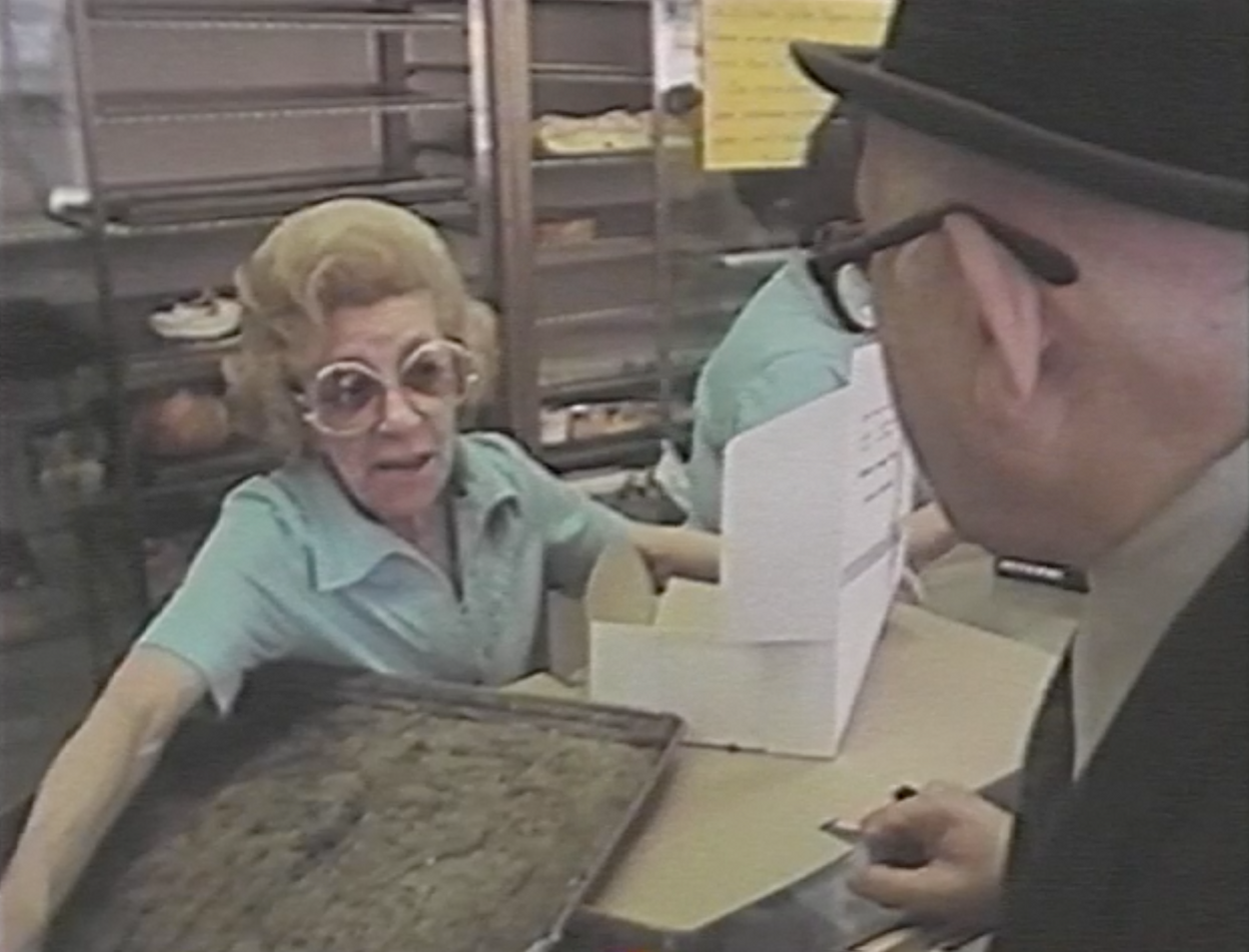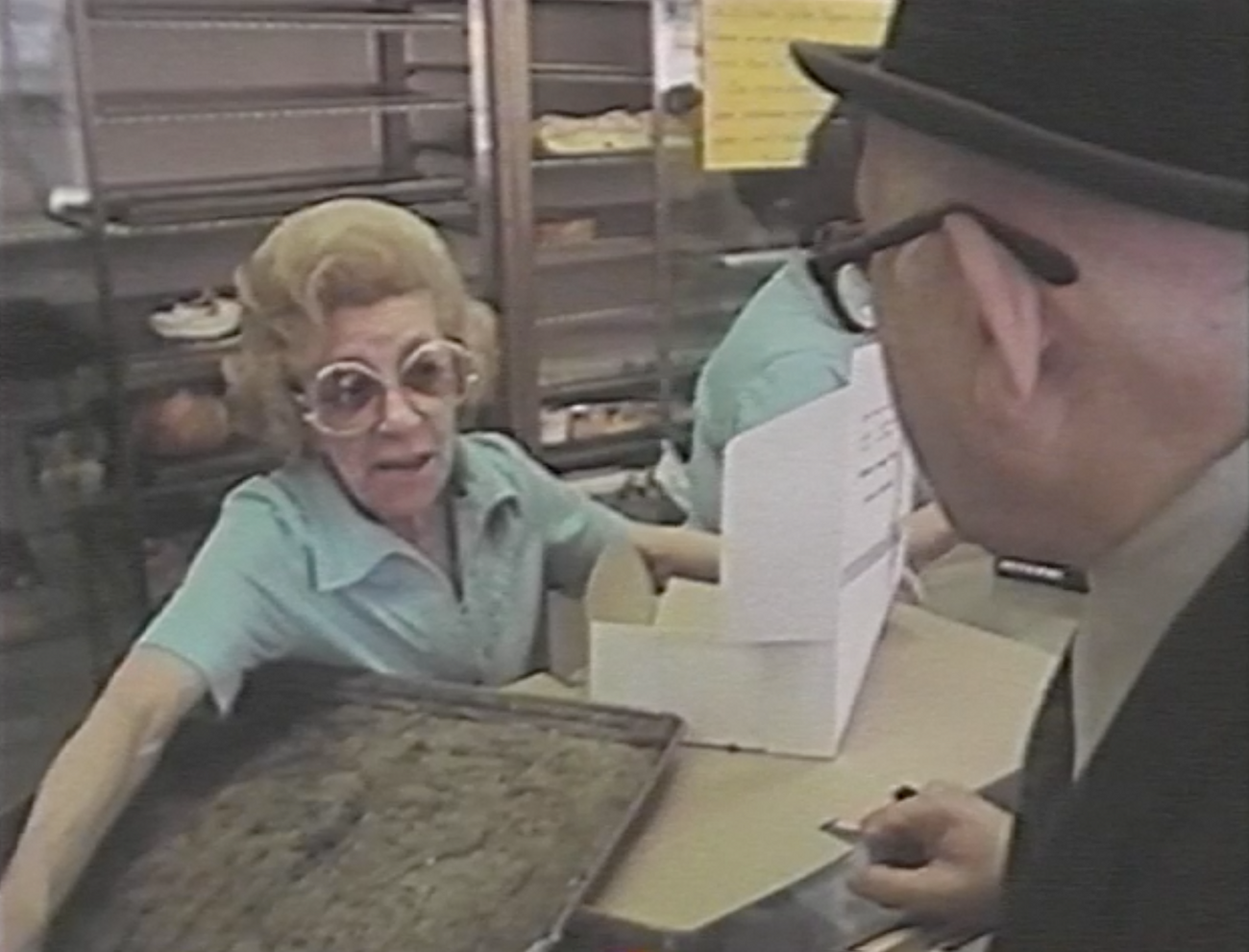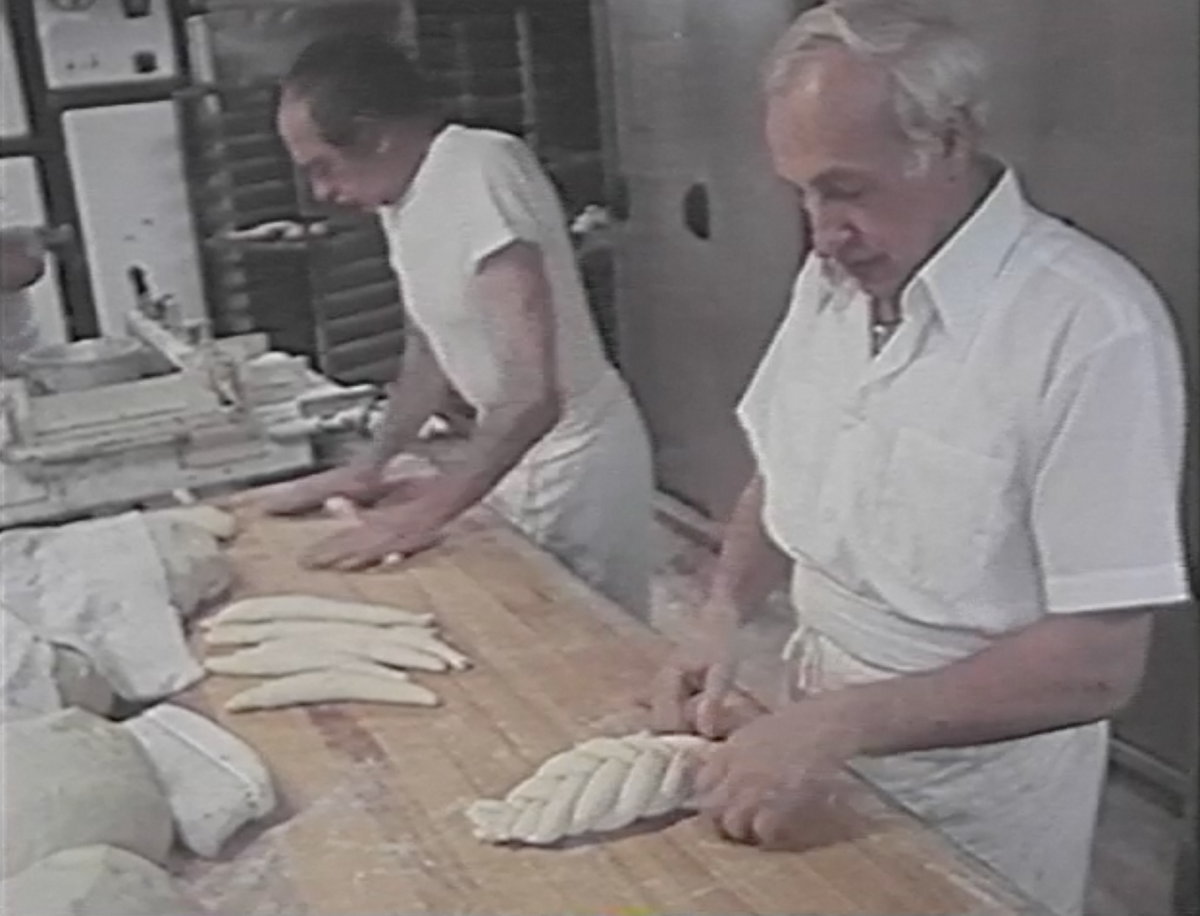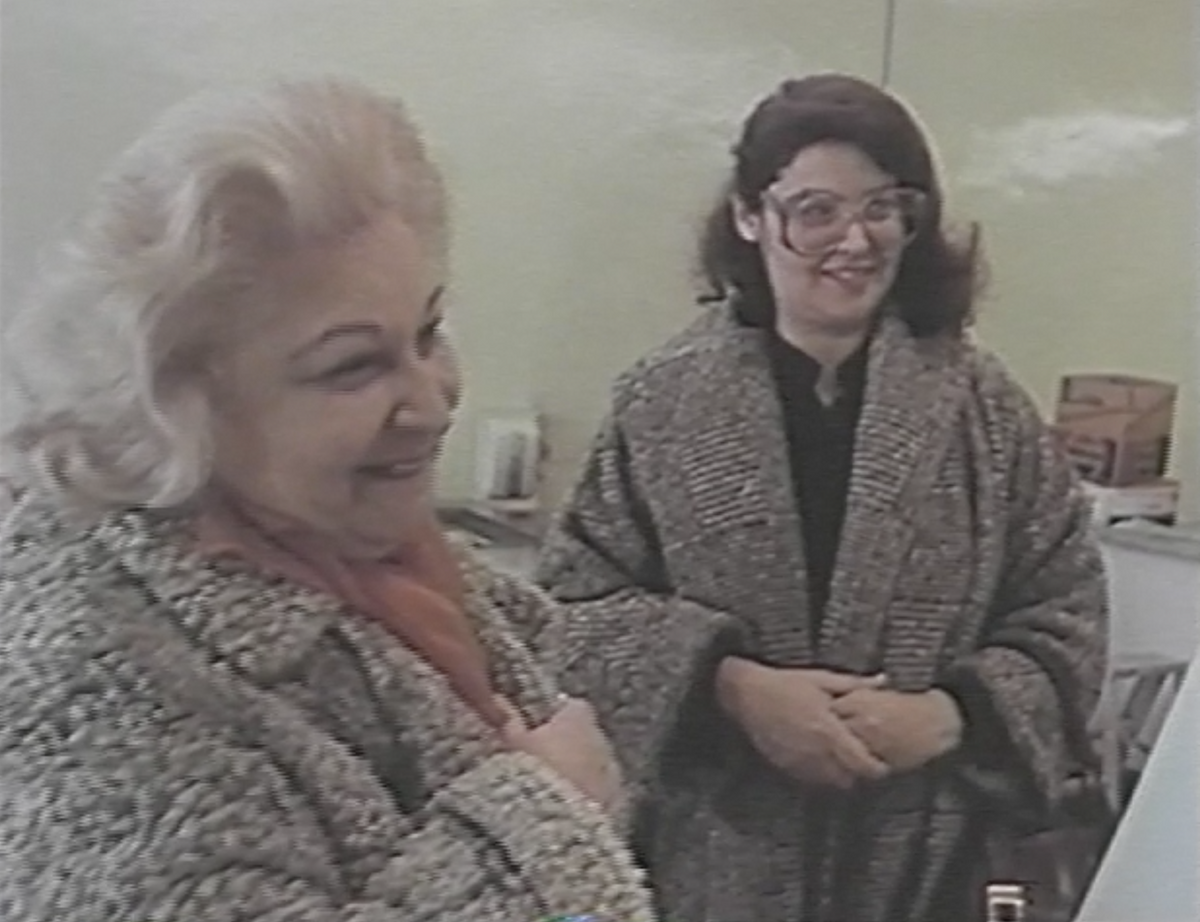The Butcher, the Baker, and the Newspaper Seller
A lost documentary captures the old Jewish shopping district of Pittsburgh’s Squirrel Hill




At the beginning of Murray Avenue: A Community in Transition, a half-hour documentary made in 1983 by Pittsburgh filmmaker Sheila Chamovitz, Rabbi Bernard Poupko exits through the front doors of Shaare Torah, where he has been the rabbi since 1942 (he would retire in 1996). He is dressed in an elegant black suit, a white shirt, and a tie, the outfit topped off by a black fedora. His cane in his right hand, he takes a right and begins a slow promenade up Murray Avenue’s steep hill, from the base of the street toward the place, several blocks along, where the storefronts begin to cluster and the business district begins in earnest. He walks slowly because of his limp, a memory of having polio as a 2-year-old in Russia, but also, one senses, because as an old man, at home in his neighborhood, he simply declines to hurry.
“You know the expression ‘yidisher gas?’” he intones, off-camera, in his deep baritone, its Eastern European accent still intact. We are watching him from behind, walking up the hill. “The ‘Jewish street’ is very characteristic, very important, in Jewish folklore and in Jewish literature,” he explains. “And whenever you want to express the idea as to what is the sentiment of the Jewish community, to this event to another, you always say, ‘vos vet men zogn af der yidisher gas?’ What are they going to talk about, what will they say, what are they saying?”—what’s the word on the street, on the Jewish street? “And Murray Avenue has become, in Pittsburgh, the yidisher gas, the Jewish street.”
The camera is now in front of Poupko; he is speaking directly to us. As he continues his walk, he offers a history lesson: “While many, many Jewish neighborhoods throughout the United States have disappeared—they moved out into other new neighborhoods, into the suburbs—Squirrel Hill is one of the very few Jewish neighborhoods which has preserved its identity, its ethnic character, for well over 80 years,” he says. “In fact, Murray Avenue, which is the very center of Squirrel Hill, is the hub of all Jewish activities and interactions.” Then the camera shifts to a higher angle, up above, most likely from the second story of one of the buildings across the street. Now Poupko looks small, far off, as he limps past Games Unlimited. This was the kind of shop that, in the early 1980s, would have sold Dungeons & Dragons, Battleship, chess sets—all fun stuff, popular with Jews to be sure, but not Jewish stuff. In fact, Games Unlimited had just arrived in 1979, and it is still open in 2020; it was a perfect example of the new kind of shop, displacing the old. As Poupko continues to amble uphill, we hear his lament: “But Murray Avenue changed.”

The source of Poupko’s melancholia is not the game store, but the very next storefront, which is now, we learn from the striped awning out front, called Bubbies. At the time that this film is being shot, it has only recently become Bubbies. For decades before, since 1943, it had been something else entirely. “This is where Silberberg’s kosher bakery was,” Poupko says. “However,” he continues, with his Old World syntax, “that which is typical of ethnicity in the United States, the first two generations continued in the same business, but the third one moved into other directions.” And as he speaks, we see footage, shot just two years earlier, of an assembly line of bakers in white T-shirts, hefting from a vat mountains of challah dough, deftly separating the dough and rolling it into long tubes, braiding them into finished loaves, then painting the loaves with an egg glaze, making it ready for the oven.
Murray Avenue is hard to find, a labor of love from the pre-digital age. It exists on VHS tape in some university libraries, and every several years somebody will produce one of the rare, privately held copies for a screening in a synagogue social hall somewhere around Pittsburgh. Chamovitz, the filmmaker, never made another movie. But to those interested in Squirrel Hill history, the movie is an indispensable document, a password, a secret handshake. If you remember and love old Squirrel Hill, then at some point you find your way to Murray Avenue, or it finds its way to you. It’s a portrait of three Jewish-owned businesses, whose proprietors Chamovitz began shooting in 1981: Silberberg’s bakery, the Federman & Fogel kosher butcher shop, and Murray Avenue News, a newsstand that, like all proper newsstands, is much more besides.
“I never studied film and am self-trained,” Sheila Chamovitz told me. “I came to filmmaking by fate.” She was born in 1946 and grew up in the Stanton Heights neighborhood of Pittsburgh. After she got married, she and her husband settled in Squirrel Hill. In 1975, when her youngest child was about to start preschool, Chamovitz was looking for a way to keep busy. One day, she bumped into the filmmaker Susan Woll, her cousin from Boston, in town making a documentary; Woll needed some help and got an eager apprentice in Chamovitz, who found documentary filmmaking “a perfect fit.” In 1978, when the American Nazi Party marched through the Jewish town of Skokie, Illinois, Chamovitz—a board member of the local ACLU—found a topic for her first directorial effort, 1980’s Skokie: Rights or Wrong. “Two dearly held values, free speech and safety for Jews, collided, and with no funding and borrowed equipment I bumbled through and made my first film.”
After the Skokie movie, Chamovitz “just wanted to do something nice and close to home.” She noticed that her beloved Squirrel Hill neighborhood had “started to change”: She had just heard that Silberberg’s bakery, which had provided Friday-night challahs and Saturday-night wedding cakes for thousands of Pittsburgh Jews, was going to close down. Other Jewish-owned businesses had closed, and what replaced them lacked the same character. Bakeries and kosher butchers were leaving; game shops and card shops and chain outlets were coming. The neighborhood of Squirrel Hill wasn’t losing its Jews, but it was losing some of its Jewishness.

Over the past 18 months, as I traveled to Squirrel Hill to report on the aftermath of the Tree of Life synagogue shooting, locals kept recommending Murray Avenue for a glimpse of the old Squirrel Hill, the one that was not just a thriving shopping district but a thriving Jewish shopping district. For the movie’s ardent fans, the feeling was that the street simply wasn’t as Jewish as it had been. And, in one sense, they are definitely right. Two of the businesses so lovingly recorded on film in Murray Avenue, the bakery and the butcher shop, are Jewish-owned and sell goods essential for the Jewish home. What could be closer to the Jewish heart and soul than the kosher chicken and the challah? These ingredients verily constitute the perfect Shabbat dinner. You make the blessing over the wine and bread, tear into the challah, serve chicken as the main course, add some sides, some green beans and noodles, put out a spread of nondairy cookies and cake for dessert—that is Friday night. That is the meal your daughter comes home from college for, the meal your son brings his new fiancée to, the meal that nourishes your widowed neighbor who has, in his grief, been forgetting to eat. Between the time Chamovitz began shooting the movie and when she finished, 1981 to 1983, both of those shops had closed. Silberberg’s bakery is now the Framesmith.
The kosher butcher and the Jewish baker were not alone in vacating Squirrel Hill. Chamovitz could have featured dozens of other businesses winking out by the late 1970s. By the time her movie debuted, there were no more classic Jewish delis in Squirrel Hill: Weinstein’s burned down in 1969, Adler’s closed a few years later. The neighborhood fish store had closed. Once upon a time, the gas station had been Jewish-owned, but the old Jacobson service station, at the corner of Murray and Forward, was now owned by Giant Eagle, the supermarket chain (which, to be fair, is Jewish-owned). Besides the butcher and the baker, many more Jewish food purveyors had opened and closed over the years—greengrocers, fruit stands, etc.—but by the 1970s it seemed that they were only closing. And—most distressing of all to the window-shoppers and flâneuses who adored the Squirrel Hill stroll—the clothing stores, once so thick on the ground that one could speak of the Squirrel Hill fashion district, had disappeared. Look through old Yellow Pages from, say, 1930 to 1970, and you will read of Tailored Miss, Adele’s, Bartlett Furs, The Coach House (men’s clothes), Dale’s Maxima (women’s), Grace Miles (women’s), Klyne’s (ditto), Frank’s Men’s Wear (later Reich/Frank), Mister Mart, and Freedman’s Men’s Wear. Karen’s Shoes closed in 1980, Maryn’s Youth Fashions in 1976, Tweed Shop in 1971 … and the list goes on. Nearly all of these businesses were Jewish-owned and, to a great extent, Jewish-patronized.
By the end of the 20th century, Jews were less interested in opening small, storefront businesses, and they were refusing to carry on family businesses, too. It’s not hard to understand why. In a scene from the bakery in Murray Avenue, Marianne Silberberg, the current proprietor’s wife and the daughter of the baker who started the business, is seen decorating a cake with a Mickey Mouse face; as she squeezes frosting from the pastry bag, she explains how her father, a German refugee, got into the business. “He wasn’t a baker. When Hitler came to Germany, and he knew that we had to leave … he decided that people always had to eat, and so he decided to go into baking. When we came to America, he worked as a helper at a bakery in Brooklyn. The one thing Dad always believed in is if you make a superior product, that people will come to you. And that’s exactly what happened. It took him a long time, and he worked himself into two heart attacks doing it. The type of business that we’ve built up can’t be run by strangers. We’ve got to be here.”
Later in the film, her husband confesses, with a bemused resignation in his voice, that his son won’t be taking over the bakery. “My son Lenny, God bless him! He really didn’t show much interest for the bakery. In a way, it was a disappointment, there is a nice, good-going bakery, and nobody to take it over. But on the other hand, I saw the handwriting on the wall, with our wages and benefits climbing every year.” Small businesses are labor-intensive to begin with; margins are low, vacation days are scarce, employees are hard to train, and skilled workers are hard to replace. Watch Silberberg and his crew braid challahs by hand, their hands faster than your eyes can follow: This is craftsmanship. Not just anyone can do it—and it is no surprise that the next generation did not want to.
Note: Relying on obituaries of Rabbi Poupko, the original version of this article said that his limp resulted from a beating as a child. It was corrected after his son, Yehiel, wrote to say, “My father Rabbi Poupko walked with a limp because as a two year old In Soviet Russia in 1919 he had polio.”
Mark Oppenheimer is a Senior Editor at Tablet. He hosts the podcast Unorthodox. He has contributed to Slate and Mother Jones, among many other publications. He is the author, most recently, of Squirrel Hill: The Tree of Life Synagogue Shooting and the Soul of a Neighborhood. He will be hosting a discussion forum about this article on his newsletter, where you can subscribe for free and submit comments.